Next year, the Russian government decided to make changes to the state mandatory Unified State Examination. In 2017, it is planned to introduce the oral part of the Unified State Examination in the Russian language. Algorithms for the oral part already exist. Same as when giving up foreign languages orally, the student listens to the task for twenty minutes and answers five questions, describing the picture and asking questions. Next, the assessors listen to the student’s recording and assign a grade. In 2017, changes should occur in the already established Unified State Examination scheme: the so-called oral part will be introduced into the Russian language exam - passing the theoretical part not in writing, but in oral form. This oral part of the Unified State Exam in the Russian language is designed to help identify the true level of knowledge of schoolchildren, because a uniform examination form is not always able to accurately reflect the full depth of knowledge in such an important and the right subject like the Russian language.
Unified State Exam 2017. Russian language
About making changes to current scheme The Unified State Exam has been discussed more than once. Over the course of several years, scientists, teachers, and even deputies have put forward their proposals. Finally, the introduction of the oral part of the Russian language exam was announced by the head of the Russian Academy of Education, Lyudmila Verbitskaya, as something accomplished. According to Verbitskaya, the request to reorganize the Unified State Examination into RAO was submitted by Rosobrnadzor. Her department has developed specific proposals for modifying the exam form. The supervisory authority is currently considering possible options conducting an oral examination and regulates the knowledge assessment system. However, according to the head of the Academy of Education, the introduction of the oral part of the exam has already been resolved, and all that needs to be done at the moment is to work out the system for passing the new exam.
Why are changes needed?
Until 2017, schoolchildren take only written Unified State Exam option In Russian. The knowledge test form is certainly good for identifying gaps in punctuation and spelling. But what about other areas? The new oral exam is designed to determine not only how well the graduate has mastered the rules of grammar, but also how well he can express his thoughts, put words into sentences and convey the meaning of the speech to the examiners. Correct speech is extremely important for building a career in modern sectors of the economy. A clear formulation of the task to subordinates is necessary for any leader, and the ability to express thoughts and convey ideas is necessary for everyone who strives to move up the career ladder. That is why it is important for a student to know not only spelling, but also to learn the basics of oratory. And forming competent speech is the task of school teachers.
ATTENTION ALL TEACHERS: according to Federal law No. 313-FZ, all teachers must be trained in first aid skills.
Presentation on the Russian language "Oral part of the OGE 2017"
Library
materials
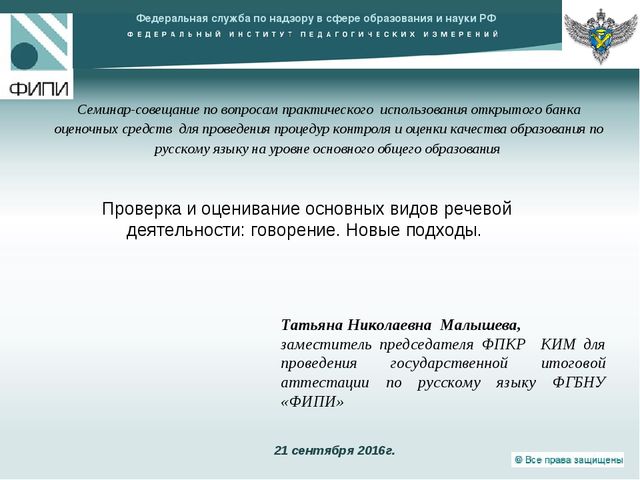
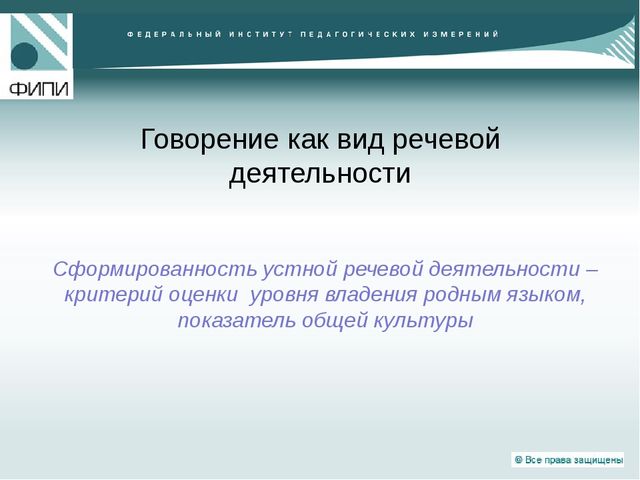
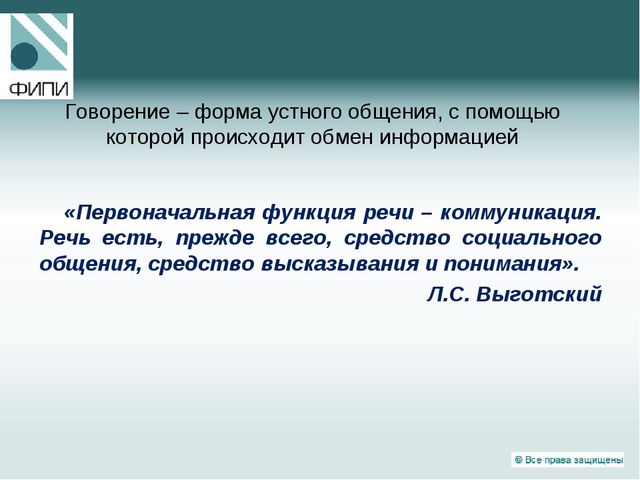
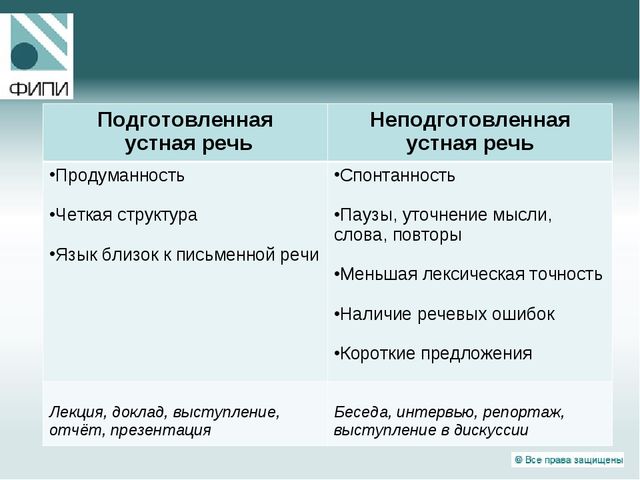
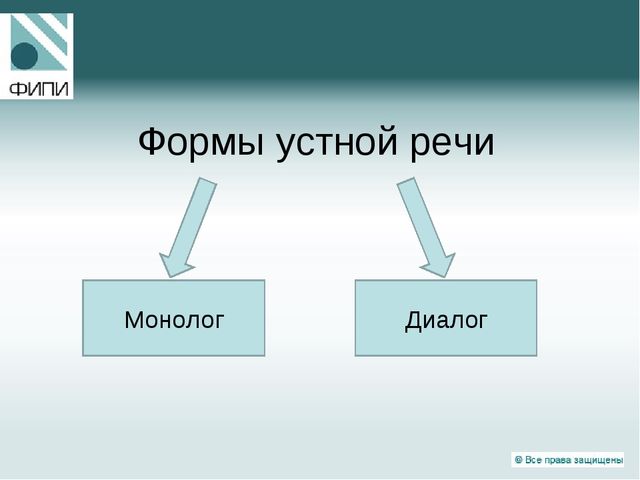
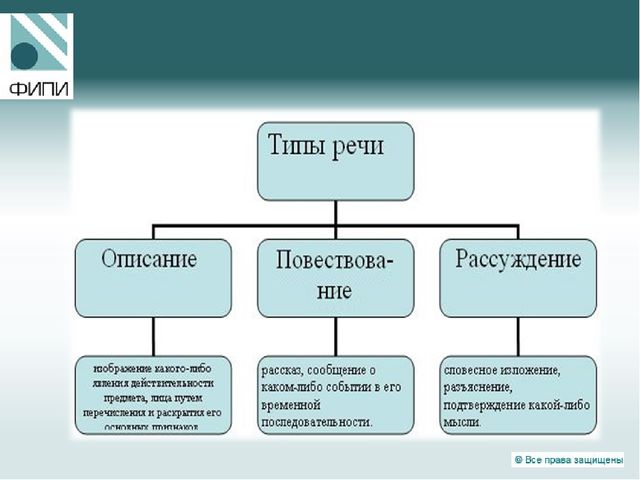
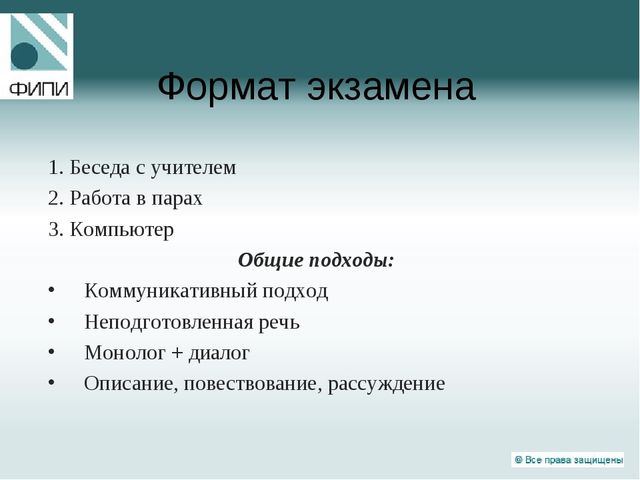
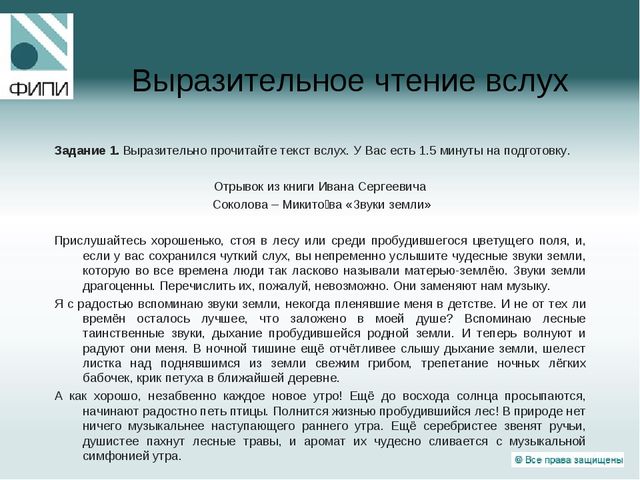
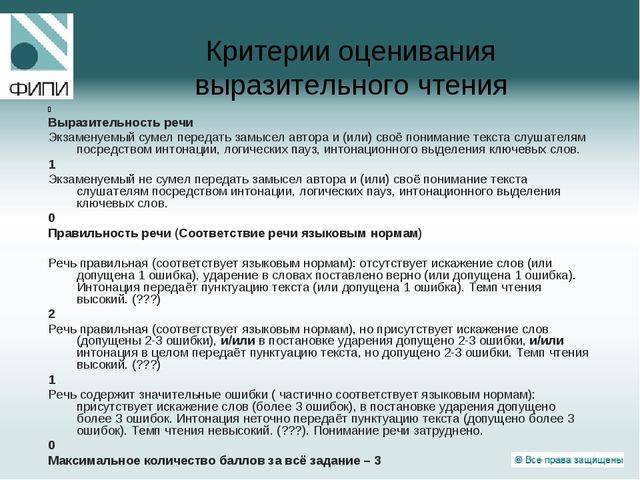
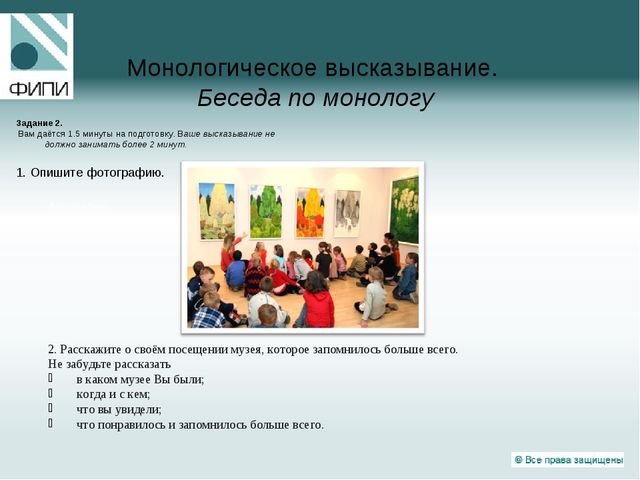
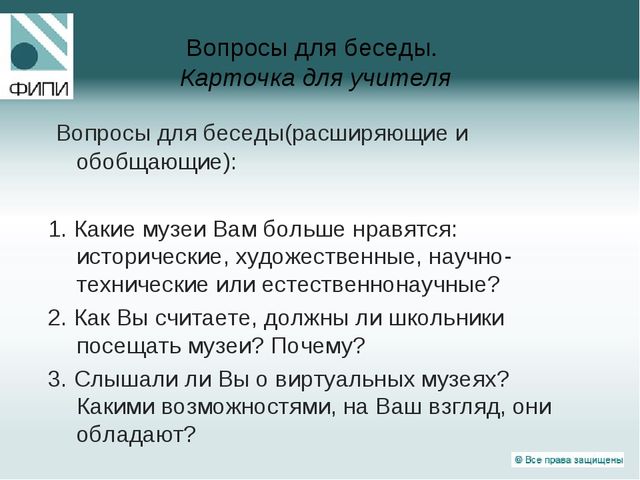
![]()
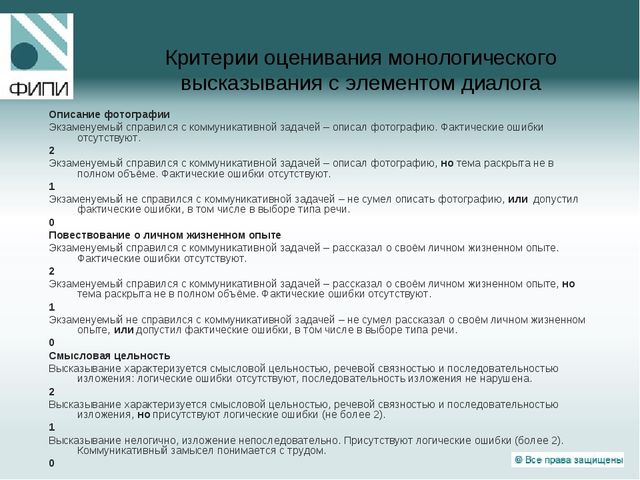
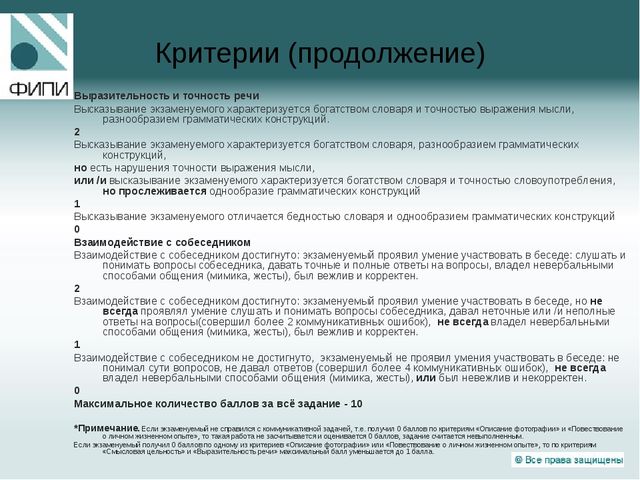
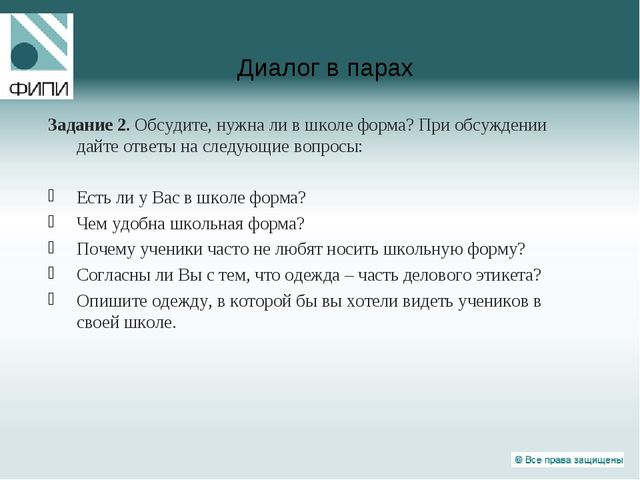
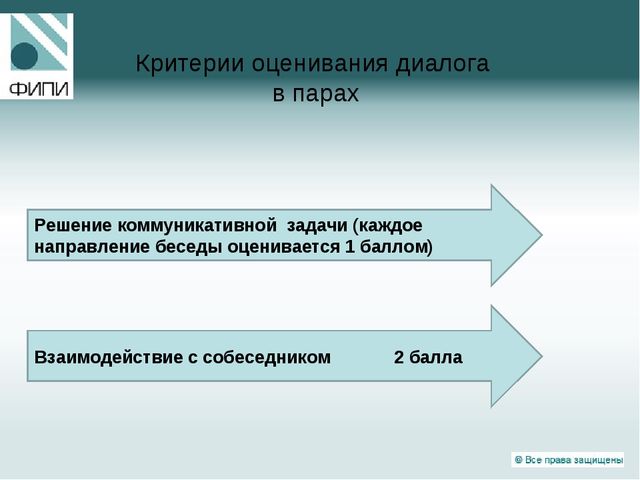
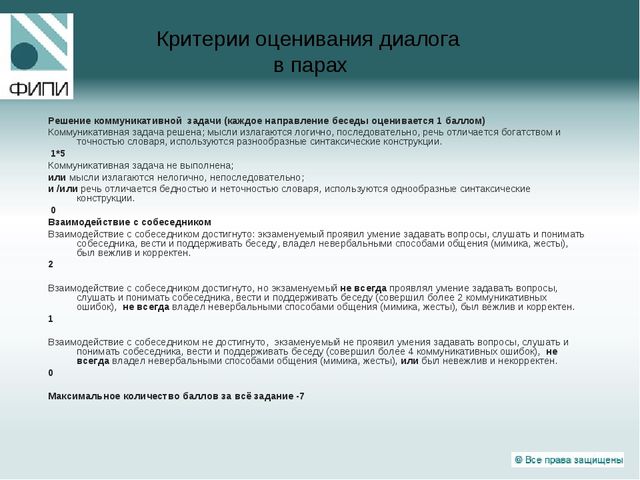
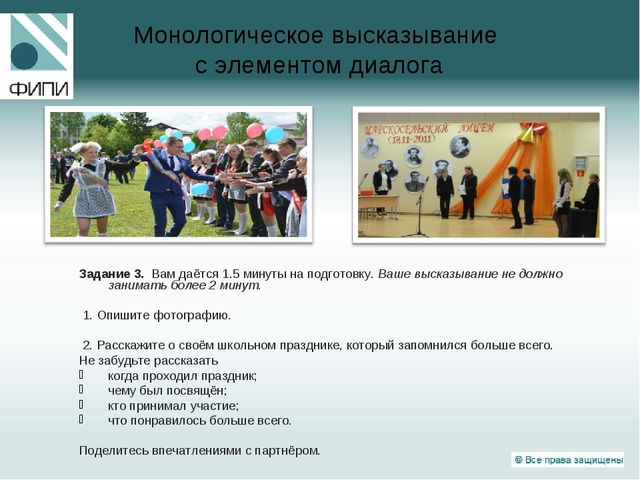
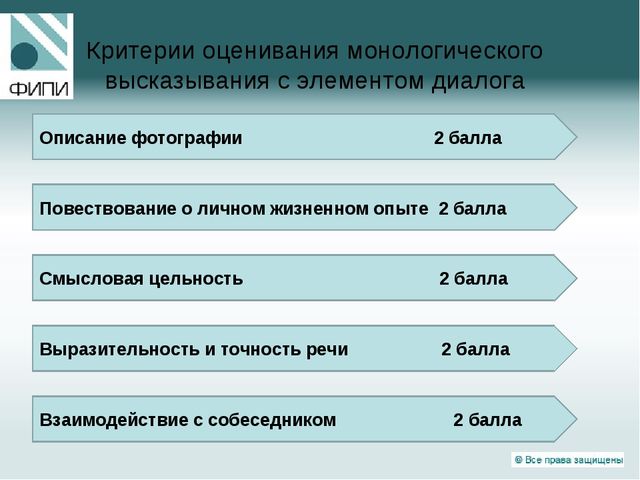
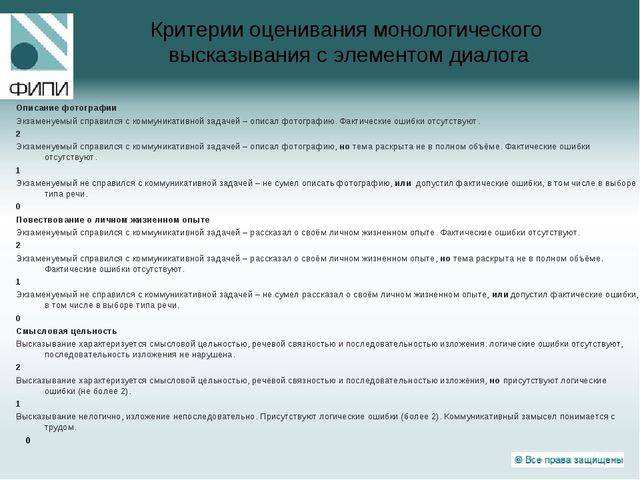
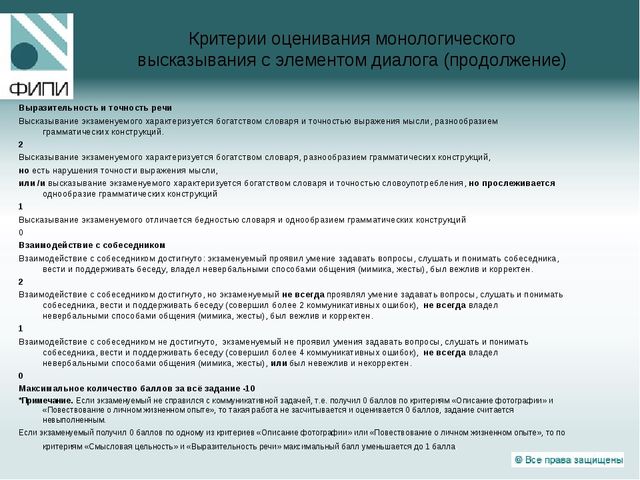
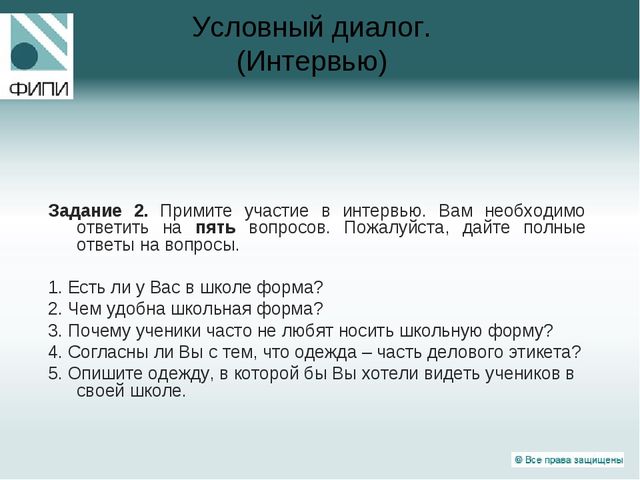
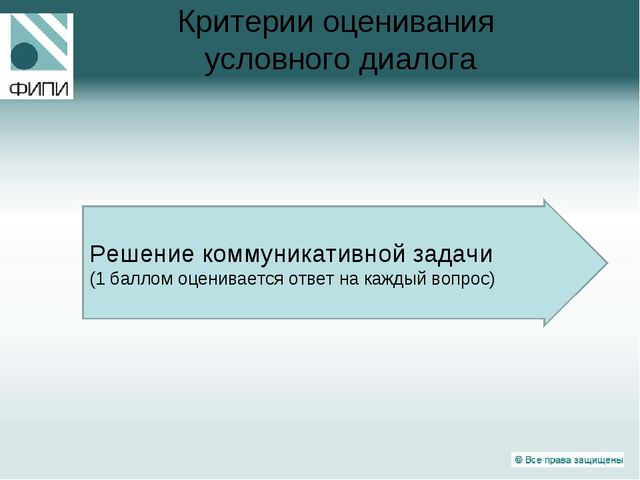
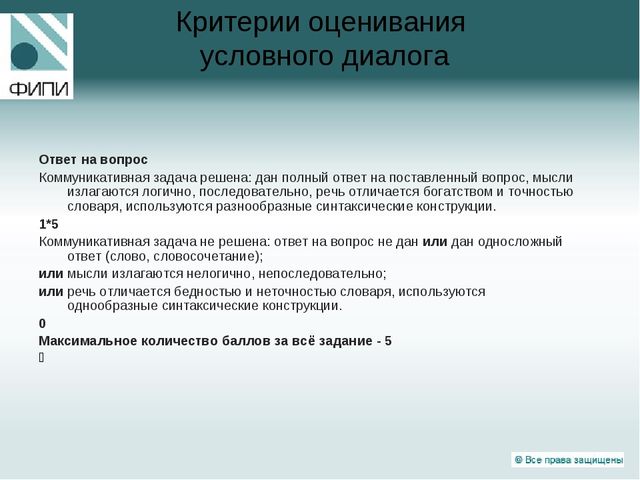
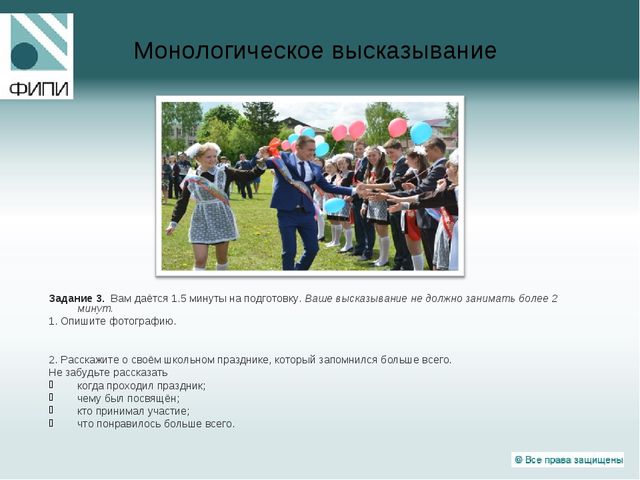
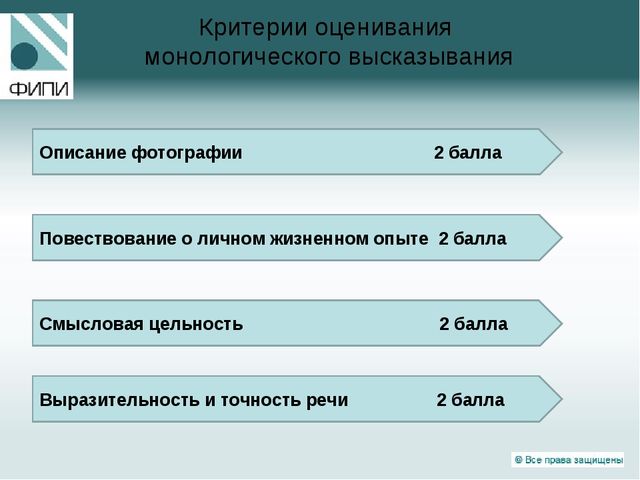

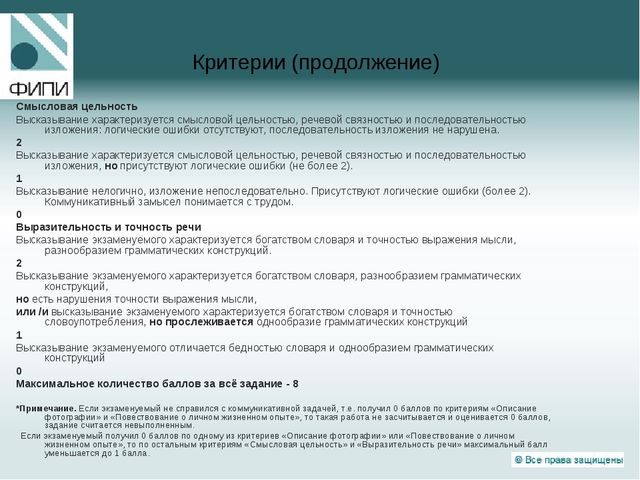
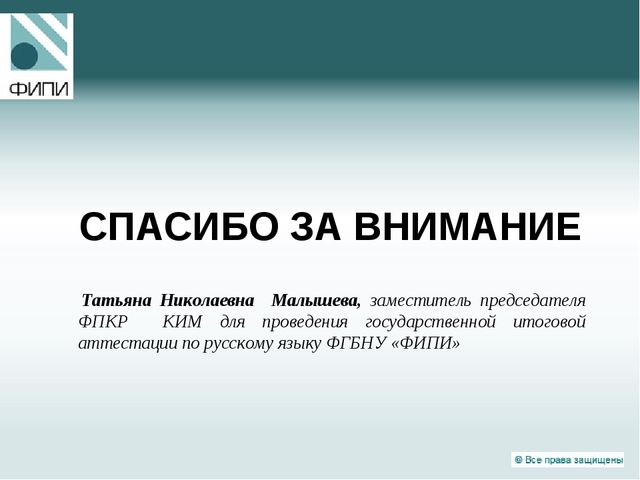
29 1
Description of the presentation by individual slides:
Slide no. 1
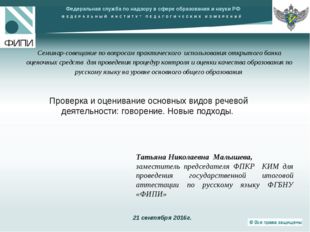
Slide description:
Tatyana Nikolaevna Malysheva, Deputy Chairman of the FPKR KIM for the state final certification in the Russian language FGBNU "FIPI" Federal Service for Supervision in Education and Science of the Russian Federation September 21, 2016 Seminar-meeting on issues practical use open bank assessment tools for carrying out procedures for monitoring and assessing the quality of education in the Russian language at the basic level general education Checking and evaluating the main types speech activity: speaking. New approaches.
Slide no. 2

Slide description:
Speaking as a type of speech activity Formation of oral speech activity – a criterion for assessing the level of proficiency in one’s native language, an indicator general culture
Slide no. 3
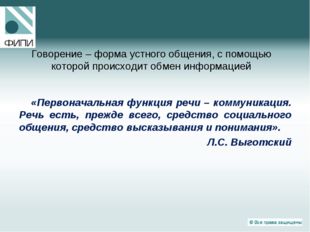
Slide description:
Speaking - form oral communication, through which information is exchanged “The primary function of speech is communication. Speech is, first of all, a means of social communication, a means of expression and understanding.” L.S. Vygotsky
Slide no. 4
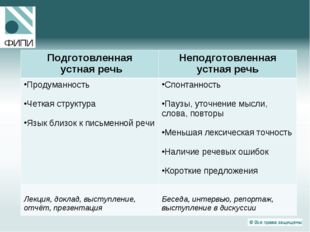
Slide description:
Prepared oral speech Unprepared oral speech Thoughtfulness Clear structure Language is close to writing Spontaneity Pauses, clarification of thoughts, words, repetitions Less lexical precision Availability speech errors Short sentences Lecture, report, speech, report, presentation Conversation, interview, report, speech in discussion
Slide no. 5
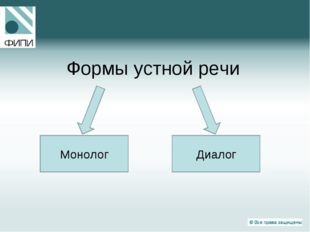
Slide description:
Slide no. 6
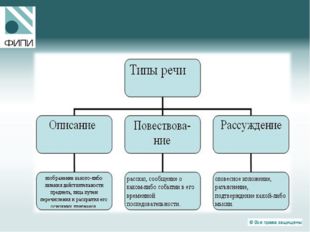
Slide description:
Slide no. 7
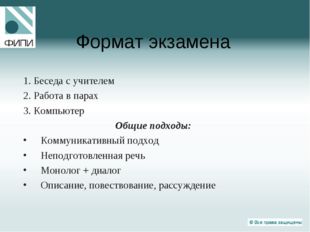
Slide description:
Exam format 1. Conversation with teacher 2. Work in pairs 3. Computer General approaches: Communicative approach Unprepared speech Monologue + dialogue Description, narration, reasoning
Slide no. 8
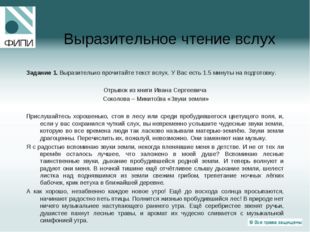
Slide description:
Expressive reading aloud Task 1. Read the text aloud expressively. You have 1.5 minutes to prepare. An excerpt from the book “Sounds of the Earth” by Ivan Sergeevich Sokolov - Mikitov Listen carefully, standing in the forest or among an awakened flowering field, and if you still have sensitive hearing, you will certainly hear the wonderful sounds of the earth, which at all times people so affectionately called mother- the ground. The sounds of the earth are precious. It is perhaps impossible to list them. They replace music for us. I remember with joy the sounds of the earth that once captivated me as a child. And is it not from those times that the best things that are embedded in my soul remain? I remember the mysterious sounds of the forest, the breath of the awakened native land. And now they excite and delight me. In the silence of the night I hear even more clearly the breath of the earth, the rustling of a leaf above the one that rose from the ground fresh mushroom, the fluttering of light night butterflies, the crow of a rooster in the nearest village. How good and unforgettable every new morning is! Even before sunrise, the birds wake up and begin to sing joyfully. The awakened forest is full of life! There is nothing in nature more musical than the early morning. The streams ring even more silvery, the forest herbs smell more fragrant, and their aroma miraculously merges with the musical symphony of the morning.
Slide no. 9
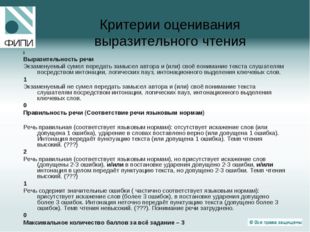
Slide description:
Criteria for assessing expressive reading Expressiveness of speech The examinee was able to convey the author’s intention and (or) his understanding of the text to listeners through intonation, logical pauses, intonation emphasis keywords. 1 The examinee failed to convey the author’s intention and (or) his understanding of the text to listeners through intonation, logical pauses, and intonational emphasis on key words. 0 Speech Correctness (Speech Correspondence language standards) The speech is correct (corresponds to language norms): there is no distortion of words (or 1 mistake was made), the emphasis in the words is placed correctly (or 1 mistake was made). Intonation conveys the punctuation of the text (or 1 mistake is made). The reading pace is high. (???) 2 The speech is correct (corresponds to language norms), but there is a distortion of words (2-3 errors were made), and/or 2-3 errors were made in the placement of stress, and/or the intonation as a whole conveys the punctuation of the text, but 2-3 mistakes. The reading pace is high. (???) 1 The speech contains significant errors (partially corresponds to language norms): there is a distortion of words (more than 3 errors), more than 3 errors were made in the placement of stress. Intonation does not accurately convey the punctuation of the text (more than 3 errors were made). The reading pace is slow. (???). Understanding speech is difficult. 0 The maximum number of points for the entire task is 3
Slide no. 10
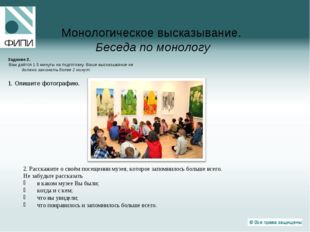
Slide description:
Monologue statement. Conversation based on a monologue photograph. 2. Tell us about your most memorable visit to the museum. Don’t forget to tell us which museum you visited; when and with whom; what did you see; what I liked and remembered most. Task 2. You are given 1.5 minutes to prepare. Your statement should not take more than 2 minutes. 1. Describe the photograph.
Slide no. 11
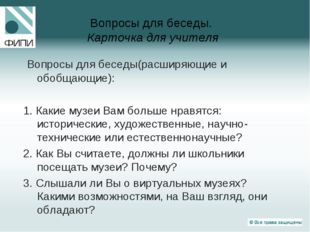
Slide description:
Questions for conversation. Card for the teacher Questions for conversation (expanding and generalizing): 1. Which museums do you like best: historical, artistic, scientific, technical or natural science? 2. Do you think schoolchildren should visit museums? Why? 3. Have you heard about virtual museums? What capabilities do you think they have?
Slide no. 12
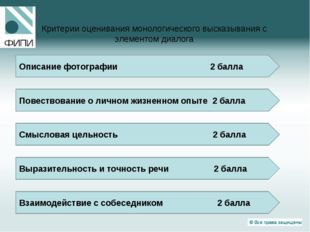
Slide description:
Slide no. 13
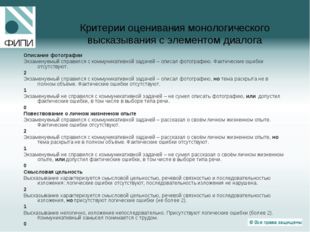
Slide description:
Slide no. 14
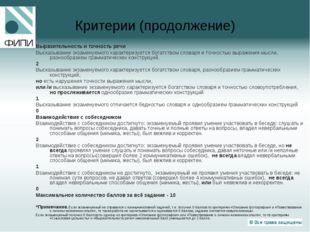
Slide description:
Criteria (continued) Expressiveness and accuracy of speech The examinee’s statement is characterized by a rich vocabulary and accuracy of expression of thoughts, a variety of grammatical structures. 2 The examinee’s statement is characterized by a rich vocabulary, a variety of grammatical structures, but there are violations of the accuracy of expression of thought, or/and the examinee’s statement is characterized by a rich vocabulary and accuracy of word usage, but the uniformity of grammatical structures can be traced 1 The examinee’s statement is characterized by a poverty of vocabulary and the monotony of grammatical structures 0 Interaction with the interlocutor Interaction achieved with the interlocutor: the examinee showed the ability to participate in a conversation: listen and understand the interlocutor’s questions, give accurate and complete answers to questions, mastered non-verbal methods of communication (facial expressions, gestures), was polite and correct. 2 Interaction with the interlocutor was achieved: the examinee showed the ability to participate in a conversation, but did not always demonstrate the ability to listen and understand the interlocutor’s questions, gave inaccurate and/or incomplete answers to questions (made more than 2 communication errors), did not always master non-verbal methods of communication (facial expressions, gestures), was polite and correct. 1 Interaction with the interlocutor was not achieved, the examinee did not show the ability to participate in the conversation: did not understand the essence of the questions, did not give answers (made more than 4 communication errors), did not always master non-verbal methods of communication (facial expressions, gestures), or was impolite and incorrect. 0 The maximum number of points for the entire task is 10 *Note. If the examinee failed to cope with the communicative task, i.e. received 0 points for the criteria “Description of the photo” and “Narration of personal life experience", then such work is not counted and is scored 0 points, the task is considered uncompleted. If the examinee received 0 points for one of the criteria “Description of a photograph” or “Narrative of personal life experience”, then for the criteria “Meaning integrity” and “Expressiveness of speech” the maximum score is reduced to 1 point.
Slide description:
Criteria for assessing dialogue in pairs Interaction with the interlocutor 2 points Solving a communicative problem (each direction of the conversation is scored 1 point)
Slide no. 17
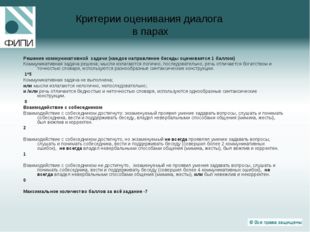
Slide description:
Criteria for assessing dialogue in pairs Solving a communicative task (each direction of the conversation is scored 1 point) The communicative task is solved; thoughts are presented logically and consistently, speech is distinguished by a rich and precise vocabulary, and a variety of syntactic structures are used. 1*5 Communication task not completed; or thoughts are presented illogically, inconsistently; and/or the speech is characterized by a poor and imprecise vocabulary, monotonous syntactic structures are used. 0 Interaction with the interlocutor Interaction with the interlocutor was achieved: the examinee showed the ability to ask questions, listen and understand the interlocutor, conduct and maintain a conversation, mastered non-verbal methods of communication (facial expressions, gestures), was polite and correct. 2 Interaction with the interlocutor was achieved, but the examinee did not always demonstrate the ability to ask questions, listen and understand the interlocutor, conduct and maintain a conversation (made more than 2 communication errors), did not always master non-verbal methods of communication (facial expressions, gestures), was polite and correct. 1 Interaction with the interlocutor was not achieved, the examinee did not show the ability to ask questions, listen and understand the interlocutor, conduct and maintain a conversation (made more than 4 communication errors), did not always master non-verbal methods of communication (facial expressions, gestures), or was impolite and incorrect. 0 The maximum number of points for the entire task is -7
Slide description:
Criteria for evaluating a monologue statement with an element of dialogue Description of the photograph 2 points Narration of personal life experience 2 points Semantic integrity 2 points Expressiveness and accuracy of speech 2 points Interaction with the interlocutor 2 points
Slide no. 20
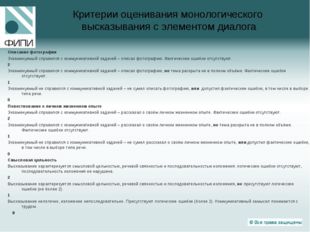
Slide description:
Criteria for assessing a monologue statement with an element of dialogue Description of the photograph The examinee coped with the communicative task - described the photograph. There are no actual errors. 2 The examinee coped with the communicative task - described the photograph, but the topic was not covered in in full. There are no actual errors. 1 The examinee failed to cope with the communicative task - he was unable to describe the photograph, or made factual errors, including in choosing the type of speech. 0 Narration about personal life experience The examinee coped with the communicative task - he spoke about his personal life experience. There are no actual errors. 2 The examinee coped with the communicative task - he spoke about his personal life experience, but the topic was not fully covered. There are no actual errors. 1 The examinee failed to cope with the communicative task - he was unable to talk about his personal life experience, or made factual errors, including in choosing the type of speech. 0 Semantic integrity The statement is characterized by semantic integrity, speech coherence and consistency of presentation: there are no logical errors, the sequence of presentation is not broken. 2 The statement is characterized by semantic integrity, verbal coherence and consistency of presentation, but there are logical errors (no more than 2). 1 The statement is illogical, the presentation is inconsistent. There are logical errors (more than 2). The communicative intent is difficult to understand. 0
Slide no. 21
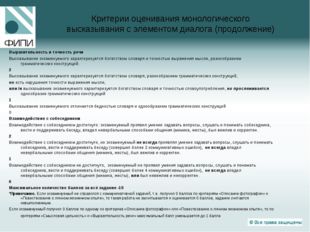
Slide description:
Criteria for assessing a monologue statement with an element of dialogue (continued) Expressiveness and accuracy of speech The examinee’s statement is characterized by a rich vocabulary and accuracy of expression of thoughts, a variety of grammatical structures. 2 The examinee’s statement is characterized by a rich vocabulary, a variety of grammatical structures, but there are violations of the accuracy of expression of thought, or/and the examinee’s statement is characterized by a rich vocabulary and accuracy of word usage, but the uniformity of grammatical structures can be traced 1 The examinee’s statement is characterized by a poverty of vocabulary and the monotony of grammatical structures 0 Interaction with the interlocutor Interaction achieved with the interlocutor: the examinee showed the ability to ask questions, listen and understand the interlocutor, conduct and maintain a conversation, mastered non-verbal methods of communication (facial expressions, gestures), was polite and correct. 2 Interaction with the interlocutor was achieved, but the examinee did not always demonstrate the ability to ask questions, listen and understand the interlocutor, conduct and maintain a conversation (made more than 2 communication errors), did not always master non-verbal methods of communication (facial expressions, gestures), was polite and correct. 1 Interaction with the interlocutor was not achieved, the examinee did not show the ability to ask questions, listen and understand the interlocutor, conduct and maintain a conversation (made more than 4 communication errors), did not always master non-verbal methods of communication (facial expressions, gestures), or was impolite and incorrect. 0 The maximum number of points for the entire task is 10 *Note. If the examinee failed to cope with the communicative task, i.e. received 0 points according to the criteria “Description of a photograph” and “Narrative of personal life experience”, then such work is not counted and is scored 0 points, the task is considered unfulfilled. If the examinee received 0 points for one of the criteria “Description of a photograph” or “Narrative of personal life experience”, then for the criteria “Meaning integrity” and “Expressiveness of speech” the maximum score is reduced to 1 point.
Slide description:
Criteria for assessing conditional dialogue Solving a communicative task (the answer to each question is scored 1 point)
Slide no. 24
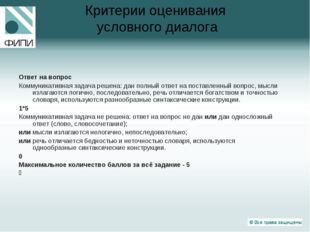
Slide description:
Criteria for assessing conditional dialogue Answer to the question The communicative task is solved: a complete answer to the question posed is given, thoughts are presented logically, consistently, the speech is distinguished by the richness and accuracy of the vocabulary, a variety of syntactic structures are used. 1*5 The communicative task has not been solved: the answer to the question has not been given or a monosyllabic answer has been given (word, phrase); or thoughts are presented illogically, inconsistently; or the speech is characterized by a poor and imprecise vocabulary, monotonous syntactic structures are used. 0 The maximum number of points for the entire task is 5
Slide description:
Criteria for assessing a monologue statement Description of a photograph 2 points Narration of personal life experience 2 points Semantic integrity 2 points Expressiveness and accuracy of speech 2 points
Slide no. 27
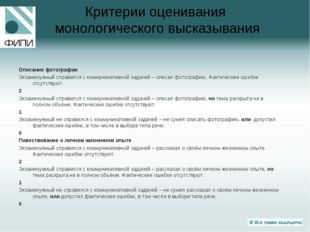
Slide description:
Criteria for assessing a monologue statement Description of a photograph The examinee coped with the communicative task - described the photograph. There are no actual errors. 2 The examinee coped with the communicative task - described the photograph, but the topic was not fully covered. There are no actual errors. 1 The examinee failed to cope with the communicative task - he was unable to describe the photograph, or made factual errors, including in choosing the type of speech. 0 Narration about personal life experience The examinee coped with the communicative task - he spoke about his personal life experience. There are no actual errors. 2 The examinee coped with the communicative task - he spoke about his personal life experience, but the topic was not fully covered. There are no actual errors. 1 The examinee failed to cope with the communicative task - he was unable to talk about his personal life experience, or made factual errors, including in choosing the type of speech. 0
Slide no. 28
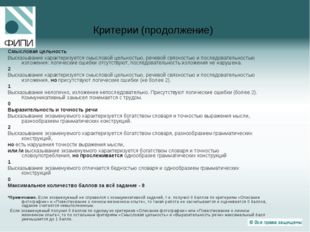
Slide description:
Criteria (continued) Semantic integrity The statement is characterized by semantic integrity, speech coherence and consistency of presentation: there are no logical errors, the sequence of presentation is not broken. 2 The statement is characterized by semantic integrity, verbal coherence and consistency of presentation, but there are logical errors (no more than 2). 1 The statement is illogical, the presentation is inconsistent. There are logical errors (more than 2). The communicative intent is difficult to understand. 0 Expressiveness and accuracy of speech The examinee’s statement is characterized by a rich vocabulary and accuracy of expression of thoughts, a variety of grammatical structures. 2 The examinee’s statement is characterized by a rich vocabulary, a variety of grammatical structures, but there are violations of the accuracy of expression of thought, or/and the examinee’s statement is characterized by a rich vocabulary and accuracy of word usage, but the uniformity of grammatical structures can be traced 1 The examinee’s statement is characterized by a poverty of vocabulary and the monotony of grammatical structures 0 Maximum number of points for entire task - 8 *Note. If the examinee failed to cope with the communicative task, i.e. received 0 points according to the criteria “Description of a photograph” and “Narrative of personal life experience”, then such work is not counted and is scored 0 points, the task is considered unfulfilled. If the examinee received 0 points for one of the criteria “Description of a photograph” or “Narrative of personal life experience”, then for the remaining criteria “Semantic integrity” and “Expressiveness of speech” the maximum score is reduced to 1 point.
Slide no. 29
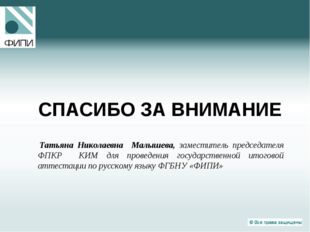
Slide description:
THANK YOU FOR YOUR ATTENTION Tatyana Nikolaevna Malysheva, Deputy Chairman of the FPKR KIM for the state final certification in the Russian language of the Federal State Budgetary Institution "FIPI"
general information
One of the possible models of the oral part of the OGE and the Unified State Exam in the Russian language.
Let us remind you that the oral part will first be held for ninth graders in 2017. Based on the testing, a decision will be made to introduce the oral part into the Unified State Examination in the Russian language.
Expressive reading aloud
Read the text aloud expressively. You have 1.5 minutes to prepare.
An excerpt from the book by Ivan Sergeevich Sokolov - Mikitov “Sounds of the Earth”
Listen carefully, standing in the forest or among an awakened flowering field, and if you still have sensitive hearing, you will certainly hear the wonderful sounds of the earth, which at all times people so affectionately called Mother Earth. The sounds of the earth are precious. It is perhaps impossible to list them. They replace music for us.
I remember with joy the sounds of the earth that once captivated me as a child. And is it not from those times that the best things that are embedded in my soul remain? I remember the mysterious sounds of the forest, the breath of the awakened native land. And now they excite and delight me. In the silence of the night, I hear even more clearly the breathing of the earth, the rustling of a leaf over a fresh mushroom rising from the ground, the fluttering of the night lungs of butterflies, the crow of a rooster in the nearest village.
How good and unforgettable every new morning is! Even before sunrise, the birds wake up and begin to sing joyfully. The awakened forest is full of life! There is nothing in nature more musical than the early morning. The streams ring even more silvery, the forest herbs smell more fragrant, and their aroma miraculously merges with the musical symphony of the morning.
Task 2. Monologue statement. Monologue conversation
You are given 1.5 minutes to prepare. Your statement should not take more than 2 minutes.
1. Describe the photo. 
2. Tell us about your most memorable visit to the museum.
Don't forget to tell:
→ which museum you visited;
→ when and with whom;
→ what did you see;
→ what I liked and remembered most.
Conversation Questions (Teacher Card)
1. Which museums do you like best: historical, artistic, scientific and technical or natural science?
2. Do you think schoolchildren should visit museums? Why?
3. Have you heard about virtual museums? What capabilities do you think they have?
Dialogue in pairs
Task 2. Discuss whether a uniform is needed at school? During the discussion, answer the following questions:
Do you have a uniform at school?
What are the benefits of a school uniform?
Why do students often dislike wearing school uniforms?
Do you agree that clothing is part of business etiquette?
Describe the clothes you would like students to wear at your school.
Conditional dialogue. (Interview)
Task 2. Take part in the interview. You need to answer five questions. Please provide complete answers to the questions.
1. Do you have a uniform at school?
2. Why is a school uniform convenient?
3. Why do students often dislike wearing school uniforms?
4. Do you agree that clothing is part of business etiquette?
5. Describe the clothes you would like students to wear at your school.
Monologue statement with an element of dialogue

1. Describe the photo.
Don't forget to tell:
→ when the holiday took place;
→ what was it dedicated to;
→ who took part;
→ what you liked the most.
Share your impressions with your partner.
Monologue statement
Task 3. You are given 1.5 minutes to prepare. Your statement should not take more than 2 minutes.
1. Describe the photo.
2. Tell us about yours school holiday, which I remember the most.
Don't forget to tell
when the holiday took place;
what was it dedicated to;
who took part;
what did you like the most?
Presentation: (downloads: 10023)
Evaluation criteria: (downloads: 7072)
